The SanDisk Extreme Portable SSD is the best-performing small travel drive you can buy
posted Tuesday, July 31, 2018 at 2:10 PM EDT
UPDATE, 10/16/2018: In the market for an ultra-fast, rugged SSD drive? This SanDisk Extreme Portable SSD is on sale today at Amazon in all capacities, including the 1TB size for just $199! Sale Over
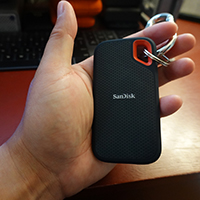
Small, portable and high capacity storage drives are more and more becoming the norm. There was a time that transporting any large amount of data was going to require a big drive with a dedicated power source. These days, looking for a one terabyte drive that is small enough to fit in your pocket isn't too much to ask for. In fact, they get smaller. The latest from SanDisk, the Extreme Portable SSD, puts 1TB of bus-powered storage with a claim of up to 550 MB/s read speeds in the palm of your hand, and it works with both USB-3 and USB-C.
If this looks a bit familiar based on the specs and even form factor, it's because it is. We recently reviewed the G-Technology 1-TB G-Drive Mobile and it shares quite a bit in common with the SanDisk. Sure, the G-Tech model has a different exterior design, promises 10 MB/s more in read speed, and costs $50 more... but that is all to be expected. The parent company of G-Tech and SanDisk is the same: Western Digital. Also, G-Technology is their "higher end," professionally-focused brand, and thus a price hike follows that logic. With that stuff known, when looking at the SanDisk I approach it from this angle: is the cheaper SanDisk (the consumer label) as good as the more expensive G-Tech?
I'm going to be referring back to the review of the G-Drive Mobile SSD, so I do recommend that you take a look at that review here.
The SanDisk Extreme SSD has a very sporty-looking design, with a thin black casing, rounded edges and a single carabiner loop in the upper right hand corner colored a nice fire-engine red. I'm a red and black fan (my two favorite colors) so this drive already had me at hello. Compared to the G-Drive SSD, it's noticeably lighter. Neither of the two drives are even close to heavy, but the SanDisk feels like it's maybe half the weight of the G-Drive. The G-Drive is 0.19 lbs and the SanDisk is "not specified by manufacturer," so you might have to take my word for it.
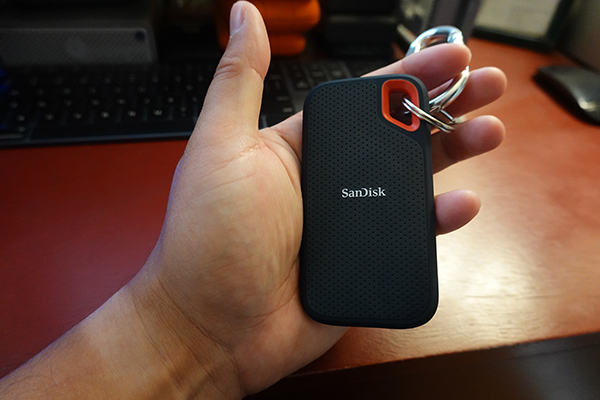
I like that the SanDisk has the carabiner hook. It's a smart addition that lets me clip it to a zipper inside my backpack so it doesn't get lost or fall into the wrong pocket. Is it entirely necessary? Not really, but it's an option and I like options.

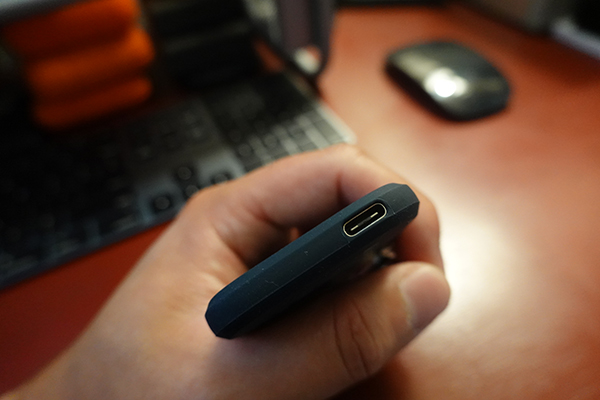
That's really all there is to discuss when it comes to the SanDisk's design. Small, light, and it has a clip. Those are important checkboxes to tick, but how does it actually perform? That's the really important question, and the entire reason to buy a drive like this. The best we were able to get out of the G-Drive performance-wise was 339.9 MB/s write speeds and 519.5 MB/s read speeds. That's pretty darn good, though it doesn't quite reach the promised 560 MB/s read speeds that G-Technology advertises. But that's our baseline to test against with the SanDisk, so let's take a look at what it can do.
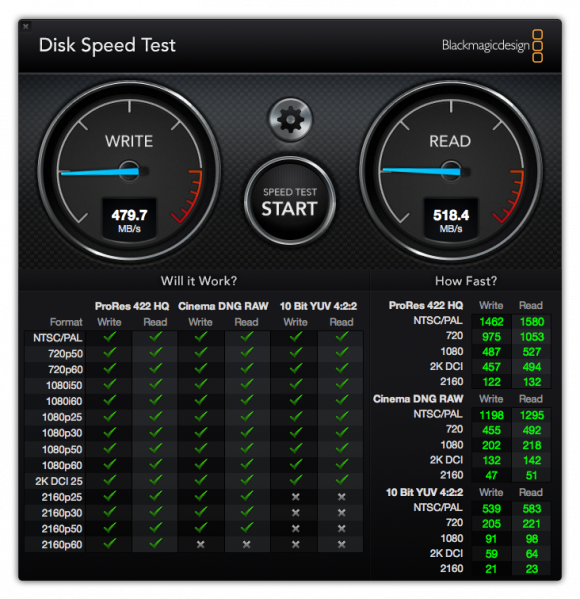
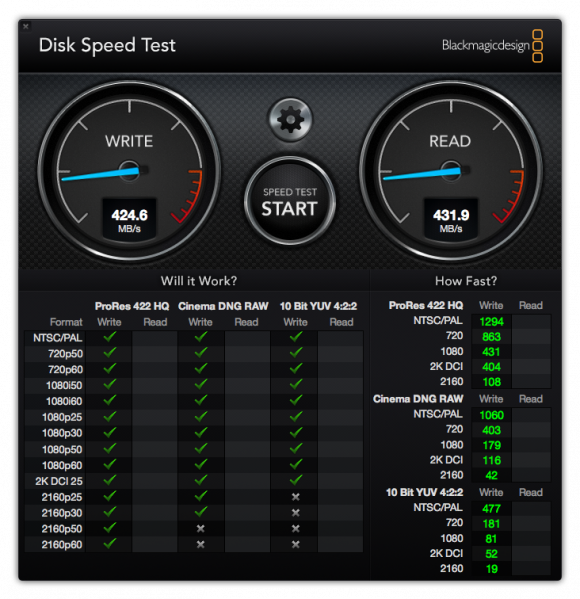
Unlike with the G-Drive, the SanDisk comes with a special USB-C cable with a small adapter for USB 3.0, a nice little addition to reduce the number of cables I own. The G-Drive shipped with two cables, a USB-C to USB-C and a USB-C to USB 3.0. Honestly, they both will work the same (more on that in a bit), but I like that the SanDisk at least tries to cut down on my cable clutter. That said, the little adapter is quite small, could easily be lost, and only works with the cable that shipped with the SanDisk (there is a little notched piece on both the USB-C end and the USB 3.0 head that only allows those two pieces to fit together). So while I like what SanDisk is doing a bit more than the G-Technology brand, I wish it wasn't so annoying as to restrict my usage.
At any rate, all testing with USB-C and USB 3.0 was done with the included cable and adapter, so as to show what you get with the parts that SanDisk specifically ships.
I pulled a Thunderbolt 3 cable out of my drawer just to see how the SanDisk performed with the T3 interface. Spoiler: badly.
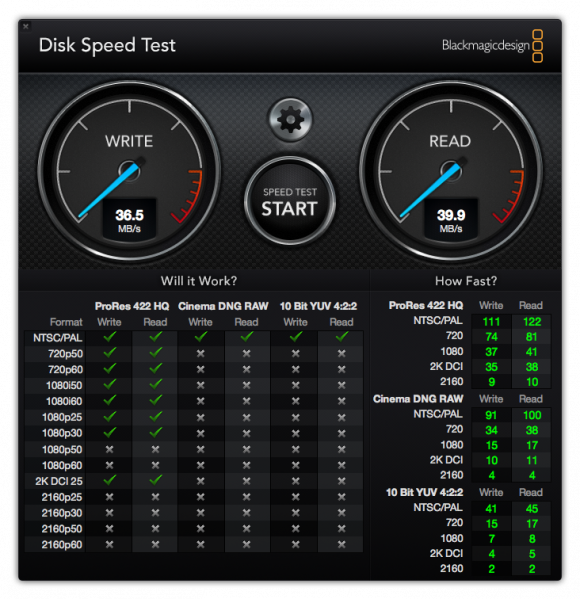
Even though they share the same physical connection, Thunderbolt 3 is a bad choice for just about anything unless that drive has specifically licensed that tech. Otherwise, T3 is not only worse than USB-C, it's almost worse than the now-antiquated USB 2.0. In other words, don't do it. I keep mentioning this in my reviews because a Thunderbolt 3 cable and a USB-C cable can look physically identical. If you just grab a cable out of a drawer and rush out the door and it happens to not be the right one, you're in for a disappointing experience. So be careful.
Looking over those results, the best performance comes when you're able to use USB-C to USB-C, but even then I was not able to hit the highest performance promised by SanDisk's marketing of 550 MB/s. Instead, the best I saw out of read speeds was 518.4 MB/s. Compared to the G-Technology SSD, this is just a hair slower (the G-Drive tested at 519.5). However, the Sandisk was able to hit 479.7 MB/s write speeds which outperforms the G-Drive's 339.9 MB/s by a significant margin. For a drive that's cheaper and marketed to the general consumer, that's great news as someone pinching pennies, but not so great for those who try and rationalize a higher price point for a more "professional" brand.
On the USB-C to USB 3.0 front, the SanDisk hit 424.6 MB/s write and 431.9 MB/s read speeds compared to the G-Drive's 397.5 MB/s write speed to 431.4 MB/s read speeds. Again, the cheaper SanDisk outperformed the G-Drive by a significant margin in the write speed category, and the read speeds may as well be the same.
I did do one more test, and that was to just see if there was a difference between using the adapter included with the SanDisk and just using a USB-C to USB-A cable. Yes, there is a difference. No, it is not significant.
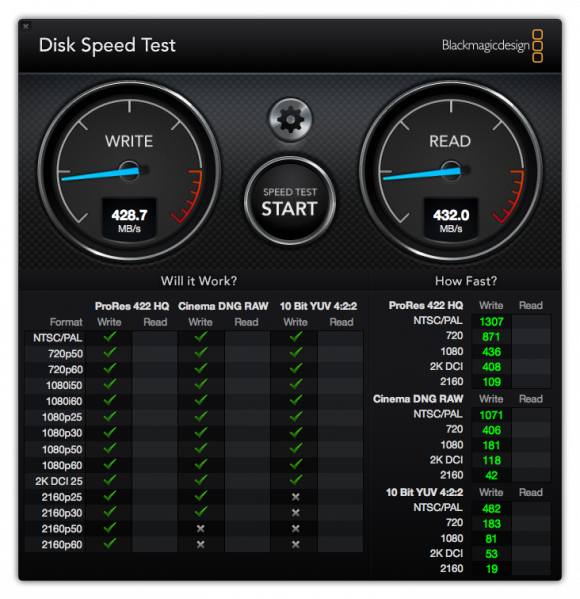
When we reviewed the G-Drive SSD, we mentioned that the performance was pretty much the same as a previous G-Technology product called the G-Drive Slim. Well, that's because it was in all likelihood the same internal parts with a "sexier" external body. That would make sense, as it's unlikely one company is going to completely engineer two totally different SSD internal parts when the internals work just fine.
I would say that the SanDisk follows that same logic if the drive didn't perform so much better than the G-Technology drives did. I wanted to believe it was the same internals across all three products, but given the difference in speeds, I'm hesitant to claim that. That said, we did test the 500GB versions of the Slim and the G-Drive SSD, so it's entirely possible that going to 1TB changes things (it often does). Do with this knowledge what you will.
Looking at the price, like the G-Drive and the Slim before it I still think the price is too high at the 1 TB level and especially at the 2 TB level. 1 TB will set you back $300 and the 2 TB doubles that ask to $600. That's a lot of money to spend on a portable travel drive that isn't likely to be a long-term storage item (I think the size makes it very easy to lose, and it's still a lot cheaper to get a 1 TB HDD for long term storage). For what these drives are intended, 500GB is generally going to be enough for a photographer who needs a backup solution on the road, and the $129 price tag for 500GB is much easier to swallow. If you don't need that much, the 250 GB option is a very price-friendly $99.
No matter what you choose, the SanDisk is going to be more affordable than the G-Technology. G-Tech's smallest option is the $158 500 GB, with their 1 TB and 2 TB options running $350 and $650 accordingly. For a drive that has either worse or the same performance as the SanDisk, I can't really see a reason to buy the G-Tech anymore, despite my praises for it in my original review. I like good branding as much as the next guy, but since SanDisk and G-Technology share a parent company and both brands have pretty pristine brand recognition, I'm not about to just shell out $50 more for an identical-at-best and inferior-at-worst product.
Pros:
- Small, lightweight and with a carabiner loop
- Nice red accent
- Available in multiple capacities, from 250 GB to 2 TB
- Fast read and write speeds from both USB-C to USB-C and USB-C to USB-A
- More affordable than other options, with the best deal likely at 500GB
Cons:
- 1 TB and 2 TB options are pricey
- Does not reach quoted read speeds from SanDisk
- Thunderbolt 3 cables give hilariously pitiful performance. Do not use them with this drive.
Other stuff:
- Pre-formatted as exFAT, and will work with Windows 10, 8.1, and 7, as well as macOS High Sierra, Sierra, and El Capitan
- It is equipped with a USB 3.1 Type-C interface and includes a USB Type-C to Type-C cable and a USB Type-C to Type-A adapter
When I travel, I always have a backup drive or two with me. In the past, that meant a lot more space than it does now, especially with SSD being much more affordable than ever. However, getting 1 TB of storage and above is still an expensive proposition and the SanDisk is no exception to that. Though it is cheaper, lighter and it even performs better than the G-Technology option, it's still going to be too pricey for most interested buyers. You're going to be best off buying the 500GB version.
If you are in the market for a drive like this, make sure you spend your money wisely. G-Technology has the more professional look and branding, but in this case you're going to want to hitch your horse to SanDisk. Not only is it cheaper, but its write speeds dramatically outperform the G-Tech equivalent. When copying over files, write speed is more important than read speed and that's what I focus on when evaluating travel drives.
Usually when you pay more for something you're getting at least a fancier, nicer looking product. In this case, the SanDisk really isn't even asking you to sacrifice that, as its design is in many ways superior to the G-Drive. It's a no-brainer if you are comparing the two: get the SanDisk Extreme SSD.